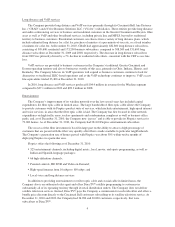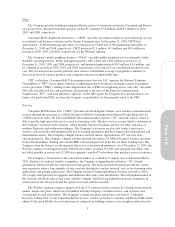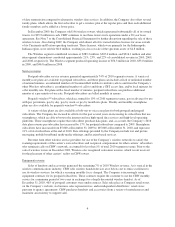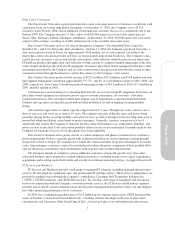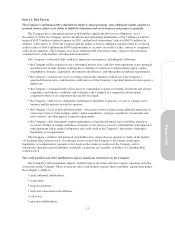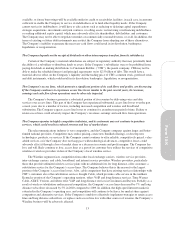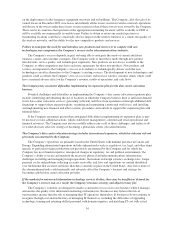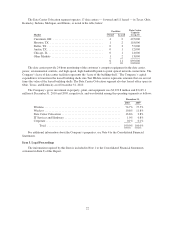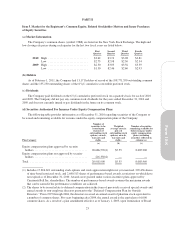Cincinnati Bell 2010 Annual Report Download - page 104
Download and view the complete annual report
Please find page 104 of the 2010 Cincinnati Bell annual report below. You can navigate through the pages in the report by either clicking on the pages listed below, or by using the keyword search tool below to find specific information within the annual report.Wireless competitors include national wireless service providers such as Verizon, AT&T, Sprint Nextel,
T-Mobile and Leap. The Company anticipates that continued competition could compress its margins for
wireless products and services as carriers continue to offer more voice minutes and data usage for equivalent or
lower service fees. The wireless industry continues to experience rapid and significant technological changes and
a dramatic increase in usage, in particular demand for and usage of data and other non-voice services. Increased
network capacity could be required to meet increased customer demand. Should the resources required to fund
the necessary network enhancements not be available, and the Company is unable to maintain its network quality
level, then the Company’s ability to attract and retain customers, and therefore maintain and improve our
operating margins, could be materially adversely affected. The Company also faces the challenge that the newest
wireless handsets are often not available to the Company due to exclusivity agreements between the national
carriers and handset vendors, such as for the iPhone™. CBW’s ability to compete will depend, in part, on its
ability to anticipate and respond to various competitive factors affecting the telecommunications industry.
The Data Center Colocation and IT Services and Hardware segments compete against numerous other data
center colocation, information technology consulting, web-hosting, and computer system integration companies,
many of which are larger, national and/or international in scope, and better financed. This market is rapidly
evolving, highly competitive, and may be characterized by over-capacity and industry consolidation. Other
competitors may consolidate with one another or acquire software application vendors or technology providers,
enabling them to more effectively compete with Data Center Colocation and IT Services and Hardware. The
Company believes that many of the participants in this market must grow rapidly and achieve significant scale to
compete effectively. This consolidation could affect prices and other competitive factors in ways that could
impede the ability of these segments to compete successfully in the market.
The competitive forces described above could have a material adverse impact on the Company’s business,
financial condition, results of operations, and cash flows.
The Company generates a substantial portion of its revenue by serving a limited geographic area.
The Company generates a substantial portion of its revenue by serving customers in the Greater Cincinnati
and Dayton, Ohio areas. An economic downturn or natural disaster occurring in this limited operating territory
could have a disproportionate effect on the Company’s business, financial condition, results of operations, and
cash flows compared to similar companies of a national scope and similar companies operating in different
geographic areas.
The regulation of the Company’s businesses by federal and state authorities may, among other things, place
the Company at a competitive disadvantage, restrict its ability to price its products and services, and threaten
its operating licenses.
Several of the Company’s subsidiaries are subject to regulatory oversight of varying degrees at both the
state and federal levels, which may differ from the regulatory scrutiny faced by the Company’s competitors. A
significant portion of CBT’s revenue is derived from pricing plans that require regulatory overview and approval.
These regulated pricing plans limit the rates CBT charges for some services while its competition has typically
been able to set rates for its services with limited restriction. In the future, regulatory initiatives that would put
CBT at a competitive disadvantage or mandate lower rates for its services could result in lower profitability and
cash flow for the Company. In addition, different regulatory interpretations of existing regulations or guidelines
may affect the Company’s revenues and expenses in future periods.
At the federal level, CBT is subject to the Telecommunications Act of 1996, including the rules
subsequently adopted by the FCC to implement the 1996 Act, which has impacted CBT’s in-territory local
exchange operations in the form of greater competition. At the state level, CBT conducts local exchange
operations in portions of Ohio, Kentucky, and Indiana, and, consequently, is subject to regulation by the Public
Utilities Commissions in those states. Various regulatory decisions or initiatives at the federal or state level may
from time to time have a negative impact on CBT’s ability to compete in its markets.
CBW’s FCC licenses to provide wireless services are subject to renewal and revocation. Although the FCC
has routinely renewed wireless licenses in the past, the Company cannot be assured that challenges will not be
brought against those licenses in the future. Revocation or non-renewal of CBW’s licenses could result in a
cessation of CBW’s operations and consequently lower operating results and cash flows for the Company.
14


